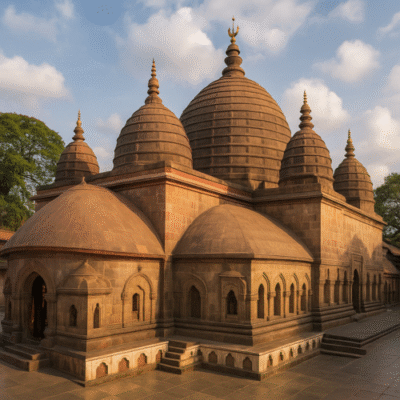Maa Kamakhya Temple: The Mysterious and Divine Shakti Peeth
High on the Nilachal Hills of Guwahati in Assam stands one of the most powerful and mysterious temples of India — Kamakhya Mandir. It is not just a temple, but a sacred place filled with devotion, mystery, and ancient stories.

Who is Maa Kamakhya?
Maa Kamakhya is a powerful form of Goddess Shakti — the divine feminine energy. She is worshipped as the goddess of desire, fertility, and power. Her name “Kamakhya” comes from “Kama” (desire) and “Akshya” (never-ending), meaning she is the one who fulfills all desires.
🔱 Why is Kamakhya Temple Special?
Kamakhya Temple is one of the 51 Shakti Peethas in India. According to ancient legends, when Goddess Sati sacrificed her life, Lord Shiva carried her body in grief. Her body parts fell at different places across the country, and each place became a holy Shakti Peeth. At Kamakhya, it is believed that her womb and yoni (female reproductive part) fell here. That is why this temple celebrates womanhood, fertility, and creation.
🌺 Myth Behind the Temple
There is a very deep and symbolic story behind this temple:
Long ago, King Daksha, father of Sati, insulted Lord Shiva during a yajna (sacred ritual). Sati could not bear the insult and jumped into the fire. Grieving, Shiva wandered across the world with her body. To stop his pain, Lord Vishnu cut her body into pieces with his Sudarshan Chakra. These pieces fell in different places. Kamakhya is where her yoni (symbol of feminine energy) fell.
Thus, this place is not just about prayer — it’s a celebration of woman’s power and the ability to give life.
According to a popular myth, demon king Narakasura fell in love with Maa Kamakhya and wanted to marry her.
The goddess agreed on one condition:
“You must build a staircase from the foot of Nilachal Hill to my temple before sunrise.”
Narakasura started the work and almost completed it. But Maa Kamakhya tricked him by killing a rooster early, making him think it was already dawn. Feeling defeated, he abandoned the task.
That incomplete staircase, called “Mekhela Ujowa Dowa”, can still be seen today. Later, Narakasura became evil, and Lord Krishna killed him. His death is celebrated as Narakasura Chaturdashi, a day before Diwali.
The Mysterious Bleeding Goddess
One of the most unique things about Kamakhya Temple is that the goddess is believed to menstruate every year during the month of June. During this time, a festival called Ambubachi Mela is held. The temple remains closed for three days. Devotees believe that Mother Earth is going through her natural cycle, and it’s a time of rest and respect.
The water in the Garbhagriha (inner sanctum) even turns red during this time — considered a divine sign!
🏛️ Temple Architecture
Kamakhya Temple is built in a beautiful Nagara-style architecture, with beehive-shaped domes and many carvings of gods and goddesses on the walls. The main sanctum does not have an idol — instead, there is a natural stone shaped like a yoni, which is always kept wet by an underground spring.
The temple also has smaller shrines dedicated to 10 Mahavidyas (ten powerful forms of Shakti), like Kali, Tara, Bhuvaneshwari, and others.
♀️ Spiritual and Tantric Importance
Kamakhya is considered the heart of Tantric Shakti worship. Many tantriks (spiritual practitioners) come here to perform rituals. But the place is open to all — devotees, tourists, and spiritual seekers.
🌿 What You’ll Experience at Kamakhya
- Peaceful vibes on top of the hill
- Red hibiscus flowers offered to the goddess
- Long queues, but full of devotion
- Blessings of a powerful goddess
- A feeling of ancient mystery and power
🙏 Final Thought
Kamakhya Mandir is more than a place of worship. It is a symbol of feminine strength, natural cycles, desire, and life itself. It teaches us that divinity exists in all aspects of life — even those that society often ignores.
So, if you ever wish to feel the deep, raw, and divine power of Maa Shakti, visit Kamakhya — where the goddess lives in her most powerful and mysterious form.
